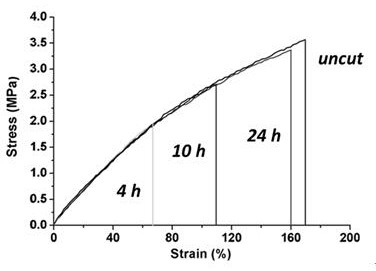A polysiloxane with high-efficiency self-healing properties and its preparation method
A technology of polysiloxane and hydroxypolysiloxane, which is applied in the chemical field, can solve the problems of low self-repair rate and achieve the effect of promoting repair, improving mechanical properties, improving migration and movement characteristics
- Summary
- Abstract
- Description
- Claims
- Application Information
AI Technical Summary
Problems solved by technology
Method used
Image
Examples
Embodiment 1
[0030] Weigh 5 g of pyridine-4-boronic acid and 60 g of white carbon black in a ball mill jar, and ball mill for 20 h at room temperature to obtain a white solid powder.
[0031] Mix the above powder with 200g polydimethylsiloxane disilanol (M n ~24KDa) was put into the internal mixer and mixed for 20 minutes to obtain a white powdery solid. The obtained solid was placed in an aluminum pan, and then heated to 160° C. in an oven for 4 hours to obtain a white hard solid. The obtained solid can be molded by heating (130°C, 12MPa).
[0032] The self-healing curve of the obtained polysiloxane sample is as follows figure 1 shown. It can be seen that the strength of the cut sample reached 99% of the original sample after 24h room temperature repair.
Embodiment 2
[0034] Weigh 5g of 4-(N,N’-dimethylamino)-phenylboronic acid and dissolve it in 20mL of tetrahydrofuran, then stir and mix with 200g of polydimethylsiloxane disilanol (Mn~24KDa). After mixing, THF was removed under reduced pressure, and the resulting clear liquid was mixed with 60 g
[0035] White carbon black was added into the internal mixer and mixed for 20 minutes to obtain a white powdery solid. The obtained solid was placed in an aluminum pan, and then heated to 160° C. in an oven for 4 hours to obtain a hard purple solid. The obtained solid can be molded by heating (130°C, 12MPa).
[0036] The self-healing curve of the obtained polysiloxane sample is as follows figure 2 shown. It can be seen that the strength of the cut sample reached 94% of the original sample after 24h room temperature repair.
Embodiment 3
[0038] Weigh 5g of 4-(N,N')-dimethylamino-phenylboronic acid and dissolve it in 20mL of tetrahydrofuran, then mix with 200g of poly(dimethyl-co-methylphenyl)siloxane disilanol (Mn~13KDa, 20%wt of phenyl) stirred and mixed evenly. After mixing, the tetrahydrofuran was removed under reduced pressure, and the obtained clear liquid and 60 g of white carbon black were added to an internal mixer and mixed for 20 minutes to obtain a white powdery solid. The obtained solid was placed in an aluminum pan, and then heated to 160° C. in an oven for 4 hours to obtain a hard purple solid. The obtained solid can be shaped by heating and pressing (150°C, 12MPa).
PUM
| Property | Measurement | Unit |
|---|---|---|
| number average molecular weight | aaaaa | aaaaa |
| tensile strength | aaaaa | aaaaa |
| number average molecular weight | aaaaa | aaaaa |
Abstract
Description
Claims
Application Information
 Login to View More
Login to View More - R&D
- Intellectual Property
- Life Sciences
- Materials
- Tech Scout
- Unparalleled Data Quality
- Higher Quality Content
- 60% Fewer Hallucinations
Browse by: Latest US Patents, China's latest patents, Technical Efficacy Thesaurus, Application Domain, Technology Topic, Popular Technical Reports.
© 2025 PatSnap. All rights reserved.Legal|Privacy policy|Modern Slavery Act Transparency Statement|Sitemap|About US| Contact US: help@patsnap.com



